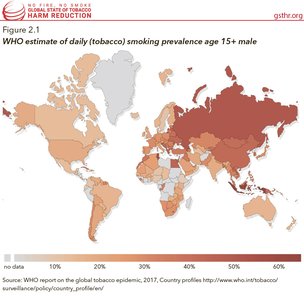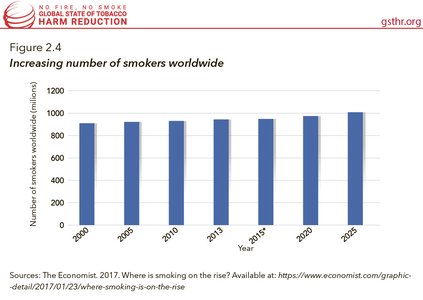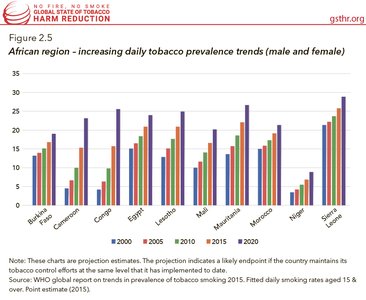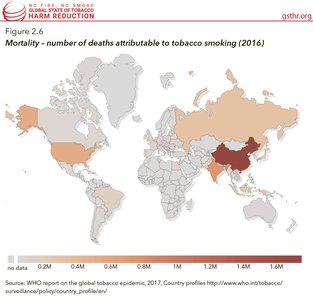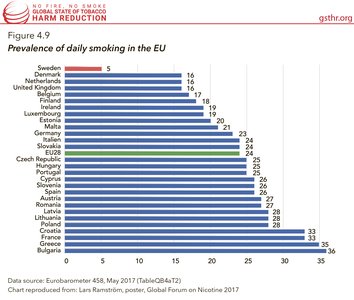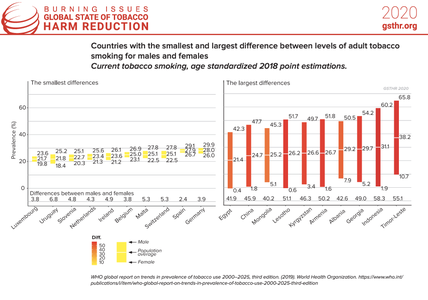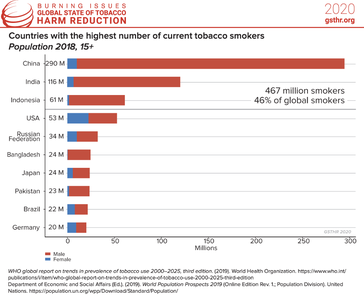Smoking
WHO Estimate of Daily (Tobacco) Smoking Prevalence Age 15+ Male
- No Fire, No Smoke: The Global State of Tobacco Harm Reduction
In many higher income countries, levels of smoking have fallen since the early 1970s, and are now low by international standards (and defined as under 20 percent of adults smoking). This is largely due to greater public awareness of the importance of a healthier lifestyle including exercise, nutrition, diet, lower alcohol consumption, as well as the introduction of various tobacco control measures including advertising bans, smoke-free environments and higher taxation.
The WHO statistics regarding male smoking prevalence in this figure demonstrate the comparison between countries based on 2015 data. Prevalence data changes over time – for example the latest UK Office for National Statistics report says 15.1% of people aged 18 years and above smoked cigarettes, considerably lower than the WHO adult smoking estimate.
See also p. 18 of the report: No Fire, No Smoke: The Global State of Tobacco Harm Reduction 2018 — Global State of Tobacco Harm Reduction (gsthr.org)
WHO Estimate of Daily (Tobacco) Smoking Prevalence Age 15+ Female
- No Fire, No Smoke: The Global State of Tobacco Harm Reduction
In many higher income countries, levels of smoking have fallen since the early 1970s, and are now low by international standards (and defined as under 20 percent of adults smoking). This is largely due to greater public awareness of the importance of a healthier lifestyle including exercise, nutrition, diet, lower alcohol consumption, as well as the introduction of various tobacco control measures including advertising bans, smoke-free environments and higher taxation.
The WHO statistics regarding female smoking prevalence in this figure demonstrate the comparison between countries based on 2015 data. Prevalence data changes over time – for example the latest UK Office for National Statistics report says 15.1% of people aged 18 years and above smoked cigarettes, considerably lower than the WHO adult smoking estimate.
See also p. 18 of the report: No Fire, No Smoke: The Global State of Tobacco Harm Reduction 2018 — Global State of Tobacco Harm Reduction (gsthr.org)
Lowest Prevalence of Smoking in High Income Countries (2015)
- No Fire, No Smoke: The Global State of Tobacco Harm Reduction
Levels of smoking in many higher income countries have fallen since the early 1970s, and are now low by international standards as shown in this figure (and defined as under 20 percent of adults smoking). This is largely due to greater public awareness of the importance of a healthier lifestyle including exercise, nutrition, diet, lower alcohol consumption, as well as the introduction of various tobacco control measures including advertising bans, smoke-free environments and higher taxation.
The WHO statistics in this figure demonstrate the comparison between countries based on 2015 data. Prevalence data changes over time – for example the latest UK Office for National Statistics report says 15.1% of people aged 18 years and above smoked cigarettes, considerably lower than the WHO adult smoking estimate.
See also p. 18 of the report: No Fire, No Smoke: The Global State of Tobacco Harm Reduction 2018 — Global State of Tobacco Harm Reduction (gsthr.org)
Increasing Number of Smokers Worldwide
- No Fire, No Smoke: The Global State of Tobacco Harm Reduction
Despite reduced and lower levels of smoking in many countries, population growth adds to the increase in the total global number of smokers. This figure illustrates the increase in the overall smoker numbers, which also forecasts further increases up until 2025.
In countries that have experienced steep falls in smoking prevalence over the years, the graphs have begun to level off, for example in Australia, suggesting there remains a substantial number of people who, for whatever reason, are determined to carry on smoking. The WHO trend data to 2025 predicts only very modest falls in smoking levels in several countries and predicts some rapid increases, mainly in Africa, the Middle East, some parts of Eastern Europe and republics of the former Soviet Union. Some of the more extreme examples include Cameroon (from 14 percent to 43 percent); Republic of Congo (from 14 percent to 48 percent) and Bahrain (from 25 percent to 60 percent).
See also p. 19 of the report: No Fire, No Smoke: The Global State of Tobacco Harm Reduction 2018 — Global State of Tobacco Harm Reduction (gsthr.org)
African Region - Increasing Daily Tobacco Prevalence Trends (Male and Female)
- No Fire, No Smoke: The Global State of Tobacco Harm Reduction
This figure, using WHO data, shows the steep gradient of increases in smoking prevalence estimates in specific African countries, where the projected increases (both sexes) in daily smoking are 5 percent and higher.
In countries that have experienced steep falls in smoking prevalence over the years, the graphs have begun to level off, for example in Australia, suggesting there remains a substantial number of people who, for whatever reason, are determined to carry on smoking. The WHO trend data to 2025 predicts only very modest falls in smoking levels in several countries and predicts some rapid increases, mainly in Africa, the Middle East, some parts of Eastern Europe and republics of the former Soviet Union. Some of the more extreme examples include Cameroon (from 14 percent to 43 percent); Republic of Congo (from 14 percent to 48 percent) and Bahrain (from 25 percent to 60 percent).
See also p. 19 of the report: No Fire, No Smoke: The Global State of Tobacco Harm Reduction 2018 — Global State of Tobacco Harm Reduction (gsthr.org)
Mortality - Number of Deaths Attributable to Tobacco Smoking (2016)
- No Fire, No Smoke: The Global State of Tobacco Harm Reduction
The numbers who die from smoking-related diseases are represented on the global map in this infographic, and it is important to be clear that it is the smoking of tobacco that is the problem. The Global Burden of Disease Study calculates that in 2016 there were an estimated 6.3 million smoking-related deaths annually: 884,000 from second-hand smoke, and 48,000 from oral tobacco (none of which were related to snus).
There is a wider global concern here which relates to the UN 2030 Sustainable Development Agenda (SDA). The preamble states that, “This Agenda is a plan of action for people, planet and prosperity. It also seeks to strengthen universal peace in larger freedom. We recognize that eradicating poverty in all its forms and dimensions, including extreme poverty, is the greatest global challenge and an indispensable requirement for sustainable development”, and that “nobody will be left behind”.
See also p. 20 of the report: No Fire, No Smoke: The Global State of Tobacco Harm Reduction 2018 — Global State of Tobacco Harm Reduction (gsthr.org)
Prevalence of Daily Smoking in EU
- No Fire, No Smoke: The Global State of Tobacco Harm Reduction
Sweden now has the lowest level of smoking among men than for any other country in Europe. According to the European Commission’s Eurobarometer 2017 report, only five percent of Swedish men now smoke. This is only one fifth of the EU average of 24 percent. The Eurobarometer report indicates that all other EU countries have a smoking prevalence three to seven times greater than Sweden. So, something is clearly different about Sweden – and the clear difference is that snus is allowed in Sweden yet banned in the other 27 EU countries.
See also p. 49 of the report: No Fire, No Smoke: The Global State of Tobacco Harm Reduction 2018 — Global State of Tobacco Harm Reduction (gsthr.org)
Number of Adult Tobacco Smokers by WHO Region
- Burning Issues: The Global State of Tobacco Harm Reduction 2020
Smoking is not disappearing. There are as many smokers in 2020 as there were in 2000, when it was estimated that there were 1.1 billion smokers. The WHO projects that it will remain at around 1.1 billion until at least 2025. Population growth has offset the decline in the proportion of smokers in the population.
Some regions now have more smokers than in 2000 and are projected to have even more by 2025, including the African, Eastern Mediterranean, and South East Asian Regions, as shown in this graphic. The absolute number of smokers is declining in the European region, the Western Pacific and the Americas.
See also p.29 of the report: Burning Issues: The Global State of Tobacco Harm Reduction 2020
Difference Between Levels of Adult Tobacco Smoking for Males and Females
- Burning Issues: The Global State of Tobacco Harm Reduction 2020
Average levels of smoking at a national level hide significant differences in the levels of smoking between males and females. Almost one third of men (30%) globally smoke compared with 10% of women.
According to WHO data for 2018, the prevalence of current tobacco smoking among men in 35 countries is above 40%. This ranges from a staggering 69% in Kiribati, to 50% in in Albania, Cyprus, Kyrgyzstan and Latvia, 45% in Greece, Mongolia and Republic of Moldova and 41% in Ukraine, the Russian Federation, Bangladesh and Samoa, as shown in this infographic.
In a few high-prevalence countries, the level of female smoking is higher than the male smoking levels found in lower prevalence countries for example, in Kiribati, Nauru, Chile and Serbia, over 40% of women smoke compared to 78 other countries where less than 30% of men smoke.
In some indigenous communities, such as the Māori, more women smoke than men (see Chapter 7 of the report: Burning Issues: The Global State of Tobacco Harm Reduction 2020) . There is some evidence that for cultural or social reasons in some countries, there may be under-reporting of female smoking.
See also p.30 of the report: Burning Issues: The Global State of Tobacco Harm Reduction 2020
Countries With the Highest Number of Current Tobacco Smokers
- Burning Issues: The Global State of Tobacco Harm Reduction 2020
This figure illustrates how almost half the world’s smokers (46%) live in just three countries. China has the largest number of current smokers at 290 million, followed by India at 116 million and Indonesia at 61 million. Together, these countries account for 467 million smokers.
Around the world high levels persist, despite major global initiatives led by WHO to reduce smoking – and despite the investment of millions of dollars in tobacco control to reduce the demand for and supply of tobacco (See Chapter 5 of the report: Burning Issues: The Global State of Tobacco Harm Reduction 2020). Average levels of smoking at a national level hide significant differences in the levels of smoking between males and females. Almost one third of men (30 percent) globally smoke compared with 10 percent of women.
According to WHO data for 2018, the prevalence of current tobacco smoking among men in 35 countries is above 40 per cent. This ranges from a staggering 69 percent in Kiribati, to 50 percent in Albania, Cyprus, Kyrgyzstan and Latvia, 45 percent in Greece, Mongolia and Republic of Moldova and 41 percent in Ukraine, the Russian Federation, Bangladesh and Samoa.
In a few high-prevalence countries, the level of female smoking is higher than the male smoking levels found in lower prevalence countries for example, in Kiribati, Nauru, Chile and Serbia, over 40 percent of women smoke compared to 78 other countries where less than 30 percent of men smoke. In some indigenous communities, such as the Māori, more women smoke than men (see Chapter 7 of the report: Burning Issues: The Global State of Tobacco Harm Reduction 2020). There is some evidence that for cultural or social reasons in some countries, there may be under-reporting of female smoking.
For more information see also p.31 of the report: Burning Issues: The Global State of Tobacco Harm Reduction 2020
